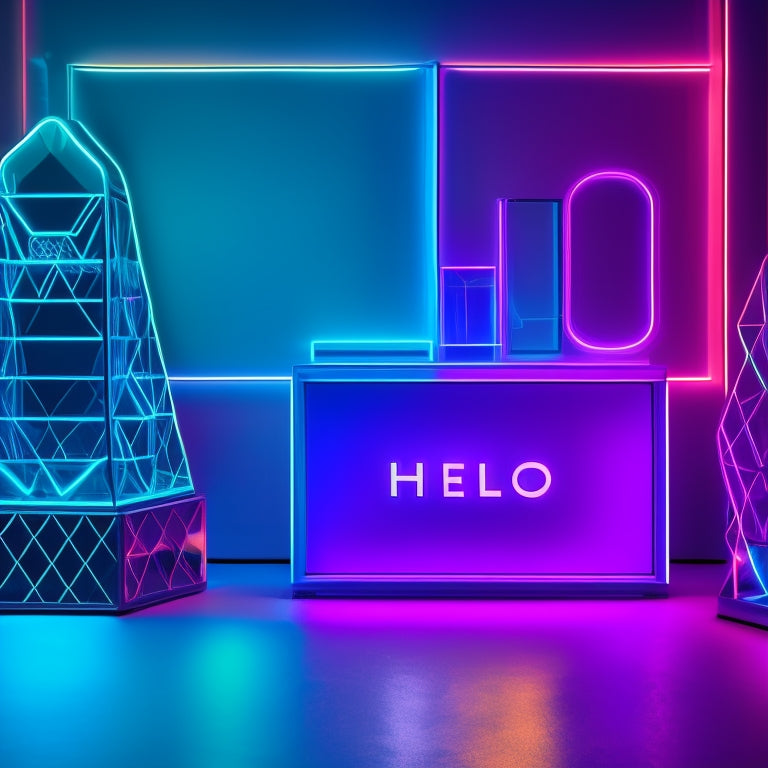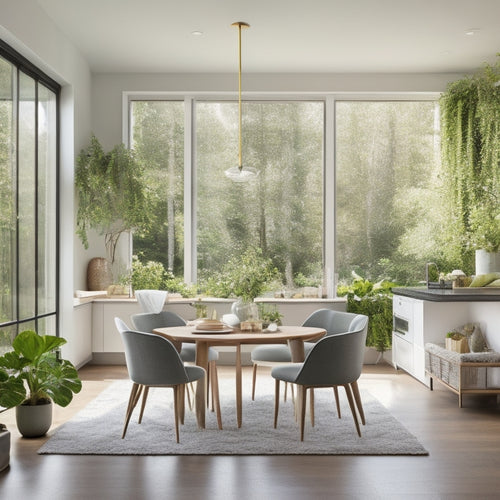
DIY Illuminated Signs: Creative LED Designs Unveiled
Share
I've created four distinctive backlit signs featuring house numbers, LOVE, HOPE, and FAITH, each showcasing unique design elements and lighting effects. To achieve this, I experimented with materials like resin casting and selected high-quality RGBW LED lights and controllers. I combined traditional woodworking with modern 3D printing techniques to create visually stunning signs. From positioning LED light strips to designing 3D-printed components, I'll guide you through the intricacies of sign construction and design. Now, let's explore the details of how I brought these creative LED designs to life, and discover the endless possibilities for customizing your own DIY illuminated signs.
Key Takeaways
• Create unique backlit signs with distinct design elements and lighting effects using materials like resin casting and 3D-printed components.
• Use high-quality RGBW LED lights and suitable controllers to achieve optimal performance and color control.
• Combine traditional woodworking and modern 3D printing techniques to construct visually stunning signs with intricate details.
• Experiment with different materials and lighting effects to create one-of-a-kind sign variations that showcase personalized styles.
• Achieve professional-looking results by following proper installation and wiring techniques, and experimenting with hanging methods for optimal light diffusion.
Project Overview and Design
I started on a project to create four unique backlit signs featuring house numbers, LOVE, HOPE, and FAITH, each incorporating distinct design elements and lighting effects that can be replicated without specialized equipment.
I aimed to push the boundaries of creativity while maintaining simplicity. Through material experimentation, I explored various construction methods, including casting resin, to achieve the desired look.
I focused on creating signs that are both visually striking and easy to replicate. By incorporating distinct design elements, such as protruding letters and clever light positioning, I aimed to create a sense of depth and visual interest.
With careful planning and attention to detail, I was able to bring these designs to life, and I'm excited to share my process with you.
Materials and Electronics Essentials
To bring these unique backlit signs to life, you'll need a range of materials and electronics. This includes LED light strips, wood, standoffs, 3D printer filament, and various hardware store items.
I've learned that materials selection is essential, so I've specified the technical specifications for each component to guarantee optimal performance. For instance, I recommend using high-quality RGBW LED lights with precise color control and a suitable controller to achieve the desired lighting effects.
When it comes to wood, I've opted for durable, easy-to-work-with options that can withstand the weight of the sign. By selecting the right materials and electronics, you'll be well on your way to creating stunning backlit signs that will impress anyone.
Sign Construction and Design
With the materials and electronics in place, it's time to immerse oneself in the intricacies of sign construction and design, where attention to detail and careful planning will bring your backlit signs to life.
As I explore the construction process, I'm excited to share my techniques for achieving unique design elements. From carefully positioning LED light strips to creating custom 3D-printed components, every step requires precision and patience.
My construction techniques involve a mix of traditional woodworking and modern 3D printing, ensuring a sturdy yet visually stunning sign. I'll walk you through the design considerations, such as protrusion of letters and color control, to help you create a truly bespoke piece.
Building Unique Sign Variations
Four distinct design variations are explored in this section to inspire creative adaptations and customizations. Each showcases unique lighting effects and construction techniques. I experimented with different materials, like casting resin, to create construction variations that can be replicated without specialized equipment.
For instance, the LOVE sign features a 3D-printed design with a warm, golden glow, while the HOPE sign incorporates a stained wood background with a modern, sleek lighting effect. By modifying design elements, such as letter protrusion and light positioning, I achieved distinct visual effects that can be adapted to suit individual styles.
Through these design modifications and creative adaptations, I encourage readers to push the boundaries of what's possible with DIY illuminated signs. Exploring new construction techniques and lighting effects can make their signs truly unique.
Lighting and Wiring Instructions
I carefully selected 5050 SMD LED lights and controllers for my signs, as they provide excellent performance and flexibility for achieving the desired lighting effects.
Next, I dove into the LED controller setup, focusing on color control to bring my designs to life.
To guarantee seamless wiring, I employed tried-and-true wiring techniques, securing a sturdy connection between the lights and controllers.
I paid close attention to the wiring layout, taking care to avoid any tangles or kinks that could compromise the lighting effects.
Installation and Display Tips
To guarantee a professional-looking installation, I mounted the signs using shorter standoff posts, which allowed for maximum light diffusion and an unobstructed view of the design elements.
When it comes to sign positioning, I recommend hanging them in a spot where they can be admired from multiple angles. This not only showcases the design but also creates an ambiance that's hard to ignore.
I experimented with different hanging methods, and I found that suspending the signs from the ceiling or a sturdy beam emphasizes the light effects. By doing so, the LED lights cast a warm glow, adding a cozy touch to any room.
With the right sign positioning and hanging, you'll be amazed at how these DIY illuminated signs can elevate the mood and atmosphere of your space.
Customization and Adaptation Options
With the installation and display of your DIY illuminated sign complete, you can now focus on making it truly one-of-a-kind by exploring various customization and adaptation options.
I encourage you to get creative and try out personalized modifications to make your sign truly unique. Want to change the font or add a personal message? No problem! You can easily modify the design files to fit your style.
Design alterations can be as simple as swapping out colors or as complex as reconfiguring the entire layout. The possibilities are endless, and I've made sure to provide you with the necessary tools and resources to make it happen.
Frequently Asked Questions
Can I Use a Different Type of LED Light Strip for My Sign?
Honestly, I've tried a gazillion LED light strips, and I'm still alive to tell the tale! For your sign, I'd recommend exploring color options and brand comparisons to find the perfect fit - maybe SK6812 or WS2812B strips for superior color accuracy and control.
How Do I Ensure Even Lighting Distribution Across the Sign?
When I'm crafting my sign, I guarantee even lighting distribution by experimenting with diffusion methods, like frosted acrylic or opal glass, and adjusting reflector angles to minimize hotspots and create a seamless glow.
Are There Any Safety Precautions for Working With Electricity and LED Lights?
'When working with electricity and LED lights, I always prioritize safety to avoid electric shock and fire hazards; I guarantee proper wiring, use surge protectors, and keep flammable materials away to prevent a DIY disaster!'
Can I Scale up or Down the Sign Designs for Larger or Smaller Spaces?
I totally get it - space constraints can be a real bummer! But, I've got good news: these sign designs offer fantastic flexibility, so I can easily scale them up or down to fit any space, no problem!
How Do I Troubleshoot Common Issues With My LED Sign, Such as Flickering?
Troubleshooting LED sign issues is like finding your way through a dark room - methodical steps lead to enlightenment. I check for Power Surge damage, confirm Dimmer Compatibility, and scrutinize wiring connections to banish flickering and other pesky problems, restoring my sign to radiant glory.
Related Posts
-

Family Harmony Achieved: Doral Home Renovation Unveiled
We designed our Doral home renovation around a simple yet powerful idea: that a unified, open space can bring our fam...
-

Emergency Sanitation Essentials for Your Needs
In emergency situations, access to proper sanitation facilities is essential for maintaining personal hygiene, preven...
-

Community Engagement: Learning Through Professions
Community engagement is a powerful tool for fostering a deeper understanding of various professions among children. B...


